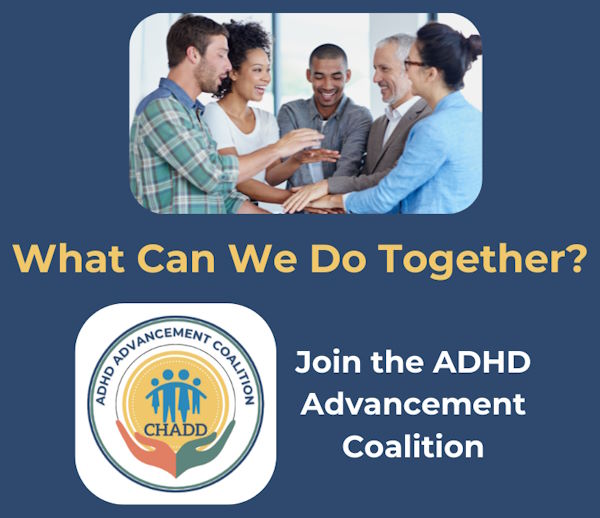-
-
-
INVEST IN YOURSELF
Tools, Strategies, and Support for Adults, Parents, Teachers, and Employers. Navigate the Complexities of ADHD.
EXPLORE TRAINING -
Leading the Way
The First Guidelines for the Clinical Diagnosis and Treatment of Adult ADHD in the United States
Learn More -
For Adults
For Parents
For Teens
For Educators
For Professionals
Recursos en español
Contact ADHD Specialist
Monday–Friday, 1–5pm ET
CALL 1-866-200-8098
¿Necesitas recursos e información sobre el TDAH? Hable con un especialista de información en español.
Find a Local CHADD
CHADD has a nationwide network of Chapters. We encourage you to find a group in your area.
Training & Events
Adult to Adult Parent to Parent Teacher to Teacher Upcoming Events
ADHD Centers Directory
Find healthcare providers for ADHD in clinics located at universities and hospitals in your area.
Professional Directory
View our directory to find local ADHD professionals in your area.
Find a ProfessionalADHD in the News 2025-04-03
April 3, 2025Waiting for What’s Next
Researchers Reveal Key Brain Differences to Explain Why Ritalin Helps Improve Focus in Some More Than Others
Study: Ritalin improves numeric memory but not overall cognition in non-ADHD adults
ViewADHD Weekly, April 3, 2025
April 3, 2025Autism Awareness Month Highlights Connection Between ASD and ADHD
Feeling Stressed? It Can Make ADHD Symptoms Seem Worse
ViewEvents
-
Training on ADHD | Self-Paced Online Courses
November 1, 2024—November 1, 2034
Register -
The Effects of Federal Healthcare and Education Policies
April 8, 2025 | 12 PM ET
Register -
ADHD Awareness Month
October 1, 2025—October 31, 2025
-
2025 International Conference on ADHD
November 13, 2025—November 15, 2025
-
Listen to podcasts about ADHD
December 1, 2025—November 1, 2034
Register -
The Role of Speech Therapy in ADHD Management Ask The Expert
March 24, 2025 | 2:00 EST
-
Identifying Misinformation About ADHD Ask The Expert
March 18, 2025 | 2:00 EDT
-
ADHD in Military Families: Challenges, Support, and Strategies Ask The Expert
March 13, 2025 | 7:00 PM ET
Register -
ADHD2025 Online Conference
March 7, 2025—March 8, 2025
Register

Attention Magazine
Recognized for its excellence, CHADD’s bimonthly magazine is rich in practical information, clinical insights, and evidence-based strategies for managing ADHD.
LEARN MOREJoin the online community for parents of children with ADHD

is neurofeedback effective with executive functioning disorder?
the neuropsychologist who diagnosed my 12yo daughter with ADHD (combined presentation) offers neuofeedback therapy at his office. of course he has told me it is effective with ADHD, but i'd rather hear the actual experiences from parents whose child is in neurofeedback therapy or completed it, especially in terms of executive functions.
Be the first to reply!
Help - advice needed for 16+ ADHD teen daughter
My adopted has ADHD has been nasty when she doesn't get her way & flies off the handle over little things & is behind on her schoolwork. Yes I know - all ADHD behavior. She wants to go to a car/motorcycle show on way home this weekend - it's a 2.5 hour detour from where we will be staying. I am in no mood to schlep so far out of the way for her
2 replies
Amantadine weight gain
Last year we tried amantadine with our son. It took the full 6 weeks for us to see any positive change. He has adhd, odd, anxiety disorder, and autism. The big change that we seen was he was hitting himself in the face less, he seemed calmer and was more responsible. The huge negative was that he had gained 15 pounds in that 6 weeks and he is alrea
Be the first to reply!
Vyvanse
What are some side effects of Vyvanse for a 11yr. old girl.
Be the first to reply!
anyone experience new phobias on focalin?
my son is on 20mg focalin xr and 2mg guanfacine daily. He has been on stimulants for over a year but the focalin is new within the past couple months. He was previously on short acting methylphenidate but we switched due to having to take it 3x per day and having issues with the unevenness of his behavior when it starting wearing off after each dos
17 replies
Single dad seeking advice – concerned my 11yo might have ADHD
Hi everyone, I’m a dad to two amazing girls, 9 and 11. I lost my wife about two years ago, and since then it’s just been me and the girls. I try my best every day to give them a good, loving home—it’s not always easy, but they’re my whole world. Lately I’ve been getting more and more concerned about my older daughter. She’s 11, and my sister kee
13 replies
DR not willing to prescribe afternoon IR
TL;DR: med coverage ends 3:30pm, child (age 8) gets home at 4pm. Child asked doctor for afternoon meds for homework and after school. Doc said no, will impact sleep. Thoughts? our 8 year old has been on a stimulant beginning this school year. It took about 2 months to get to a formulation and dosage that he seemed to respond well to. With shorta
10 replies
Troubles with using the bathroom
My son is 8 years old and has surprisingly been potty trained since he was 1 but one thing we still haven't been able to master is actually getting the pee in the toilet. Almost always ends up as floor "decoration". I know this is fairly common with ADHDers. Curious if anyone has been through similar situations and if they have found any helpful ti
5 replies
Free Webinar: The Effects of Federal Healthcare and Education Policies
April 8, 2025 | 12 PM ET Presented by CHADD's Advocacy & Public Policy Committee Several proposed federal policies have the potential to affect ADHD diagnosis, treatment, and educational support for individuals and families. Experts in ADHD diagnosis and treatment will review research-based responses to the Make America Healthy Again (MAHA) Comm
2 replies
Participants Needed for ADHD & Exercise Study!
We are recruiting children aged 8-11 with ADHD for a research study at Teachers College, Columbia University! This study examines how aerobic exercise affects executive functions in children with ADHD.
What’s Involved?
1 familiarization visit (1 hour)
3 exercise visits (1.5 hours each) over a month
Running/walking on a treadmill
Be the first to reply!
Join the online community for adults with ADHD

Recently diagnosed with ADHD and seeking online support from groups or individuals.
Hi,I'm Derek, from New Zealand. I was recently diagnosed with ADHD and I'm seeking support from others ADHDers via online groups or individuals. My Psychiatrist forwarded this site to me, so I hope it helps. I'm kind of desperate.
1 replies
Bit bummed out but hey!
I posted the first part of some information packed guide for the neurotypical partners in hope that it could potentially help a relationship or marriage from fracturing. I thought people would really benefit from my passion and real life experiences. But it was in violation of the rules, classed as advertising and shit!! Completely nothing to do w
2 replies
My parnter has adhd and I'm looking for advice
Hi I'm new here but I thought I would give it a shot . Me and my partner have been together for 3 years engaged for 1 . He has adhd it's diagnosed but not treated.I've researched many things to try and learn more about it but there is a lot of problems in our relationship which h stem from his adhd he has agreed that is the case . However whenever
8 replies
Letting Go with no guilt attached
I do not know what to do anymore....I have to vent, sorry, I know also, I should get assessed because I had so much trouble in school .....but that is another story About my son who is a very kind young man but very addicted to his games and his videos on xbox which has been told to me by an occupational therapist, that he has to get rid of all s
4 replies
Getting organized this spring
Spring cleaning? Use these tips and strategies to organize your space to increase productivity. https://chadd.org/for-adults/organizing-the-home-and-office-space/
Be the first to reply!
Adderall Shortage
Anybody else really being affected STILL by this adderall shortage?? Every month it’s the same rollercoaster of am I going to get my meds and when I have to miss because of the shortage I feel like I’m unable to do anything until i can finally get it refilled
4 replies
Free Webinar: The Effects of Federal Healthcare and Education Policies
Several proposed federal policies have the potential to affect ADHD diagnosis, treatment, and educational support for individuals and families. Experts in ADHD diagnosis and treatment will review research-based responses to the Make America Healthy Again (MAHA) Commission’s claims about ADHD. They will also discuss the critical role the US Departme
Be the first to reply!
Has or is anyone else taking Modafinil 200mg for their ADHD? How do you feel about it? I just started taking Modafinil & it helps me.
Has or is anyone else taking Modafinil 200mg for their ADHD? How do you feel about it? I just started taking Modafinil & it helps me. I tried Concerta and Vyvanse and I couldn't stand them. They made me edgy, irritable, and caused me to have high blood pressure. Now Modafinil makes me feel focused and alert.
3 replies
I had my dream job in film, then I had a dozen meltdowns
I’m not going to hide what happened, not here at least. I have been working in the film industry since 2007. I had worked my way up, knowing I had adhd, but never taking the opportunity to learn about it. I had a ridiculously lax perception of the severity of my disorder. I wasn’t hyperactive, so I brushed it off as a minor inconvenience. For years
2 replies
Diagnosis coming late in life...Introduction
Hi, I am new to this forum. I was diagnosed in my 50s only after many bouts of depression. Ironically, my Dad was diagnosed later in life and a brother was diagnosed after college. No one ever suggested I might have ADHD because 1) I wasn't fidgety or overactive, 2) I got straight As in school and graduated suma cum laude from graduate school,
8 replies
Membership
CHADD membership makes the Difference. When you become a member, you become part of our mission to improve the lives of those affected by ADHD.
Become a Member
Donate
Every dollar you give, whether large or small, makes a difference in the work we do. Your donation ensures CHADD can keep the focus on all things ADHD.
Donate Today
Volunteer
CHADD’s dedicated volunteers play an integral part in the organization’s success by providing support, education and encouragement to parents, educators and professionals.
Ways to Volunteer
Chapter Services
CHADD has a nationwide network of Chapters. We encourage you to find a group in your area. This is the best way to connect with resources and find a local ADHD support group that you can share with.
Find a Chapter













